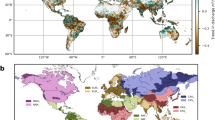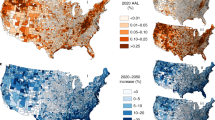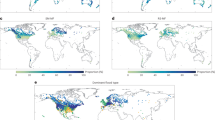Abstract
Understanding global future river flood risk is a prerequisite for the quantification of climate change impacts and planning effective adaptation strategies1. Existing global flood risk projections fail to integrate the combined dynamics of expected socio-economic development and climate change. We present the first global future river flood risk projections that separate the impacts of climate change and socio-economic development. The projections are based on an ensemble of climate model outputs2, socio-economic scenarios3, and a state-of-the-art hydrologic river flood model combined with socio-economic impact models4,5. Globally, absolute damage may increase by up to a factor of 20 by the end of the century without action. Countries in Southeast Asia face a severe increase in flood risk. Although climate change contributes significantly to the increase in risk in Southeast Asia6, we show that it is dwarfed by the effect of socio-economic growth, even after normalization for gross domestic product (GDP) growth. African countries face a strong increase in risk mainly due to socio-economic change. However, when normalized to GDP, climate change becomes by far the strongest driver. Both high- and low-income countries may benefit greatly from investing in adaptation measures, for which our analysis provides a basis.
This is a preview of subscription content, access via your institution
Access options
Subscribe to this journal
Receive 12 print issues and online access
$209.00 per year
only $17.42 per issue
Buy this article
- Purchase on Springer Link
- Instant access to full article PDF
Prices may be subject to local taxes which are calculated during checkout



Similar content being viewed by others
References
IPCC Managing the Risks of Extreme Events and Disasters to Advance Climate Change Adaptation (Cambridge Univ. Press, 2012); http://ipcc-wg2.gov/SREX/report
Hempel, S., Frieler, K., Warszawski, L., Schewe, J. & Piontek, F. A trend-preserving bias correction—the ISI-MIP approach. Earth Syst. Dynam. 4, 219–236 (2013).
O’Neill, B. C. et al. Meeting Report of the Workshop on The Nature and Use of New Socioeconomic Pathways for Climate Change Research (NCAR, 2012); https://www2.cgd.ucar.edu/sites/default/files/iconics/Boulder-Workshop-Report.pdf
Winsemius, H. C., Van Beek, L. P. H., Jongman, B., Ward, P. J. & Bouwman, A. A framework for global river flood risk assessments. Hydrol. Earth Syst. Sci. 17, 1871–1892 (2013).
Ward, P. J. et al. Assessing flood risk at the global scale: Model setup, results, and sensitivity. Environ. Res. Lett. 8, 044019 (2013).
Hirabayashi, Y. et al. Global flood risk under climate change. Nature Clim. Change 3, 816–821 (2013).
NatCatSERVICE (Munich RE, accessed 15 August 2013).
Jongman, B., Ward, P. J. & Aerts, J. C. J. H. Global exposure to river and coastal flooding—long term trends and changes. Glob. Environ. Change 22, 823–835 (2012).
Visser, H., Petersen, A. C. & Ligtvoet, W. On the relation between weather-related disaster impacts, vulnerability and climate change. Climatic Change 125, 461–477 (2014).
Jongman, B. et al. Increasing stress on disaster-risk finance due to large floods. Nature Clim. Change 4, 264–268 (2014).
Brown, C., Meeks, R., Ghile, Y. & Hunu, K. Is water security necessary? An empirical analysis of the effects of climate hazards on national-level economic growth. Phil. Trans. A 371, 20120416 (2013).
Pappenberger, F., Dutra, E., Wetterhall, F. & Cloke, H. Deriving global flood hazard maps of fluvial floods through a physical model cascade. Hydrol. Earth Syst. Sci. 16, 4143–4156 (2012).
Sampson, C. C. et al. A high-resolution global flood hazard model. Wat. Resour. Res. 51, 7358–7381 (2015).
Ward, P. J. et al. Usefulness and limitations of global flood risk models. Nature Clim. Change 5, 712–715 (2015).
Milly, P. C. D., Wetherald, R. T., Dunne, K. A. & Delworth, T. L. Increasing risk of great floods in a changing climate. Nature 415, 514–517 (2002).
Arnell, N. W. & Gosling, S. N. The impacts of climate change on river flood risk at the global scale. Climatic Change http://dx.doi.org/10.1007/s10584-014-1084-5 (2014).
Ceola, S., Laio, F. & Montanari, A. Satellite nighttime lights reveal increasing human exposure to floods worldwide. Geophys. Res. Lett. 41, 7184–7190 (2014).
Jongman, B. et al. Declining vulnerability to river floods and the global benefits of adaptation. Proc. Natl Acad. Sci. USA 112, E2271–E2280 (2015).
Hall, J. W. et al. Quantified scenarios analysis of drivers and impacts of changing flood risk in England and Wales: 2030–2100. Glob. Environ. Change 5, 51–65 (2003).
De Moel, H., Aerts, J. C. J. H. & Koomen, E. Development of flood exposure in the Netherlands during the 20th and 21st century. Glob. Environ. Change 21, 620–627 (2011).
Taylor, K. E., Stouffer, R. J. & Meehl, G. A. An overview of CMIP5 and the experiment design. Bull. Am. Meteorol. Soc. 93, 485–498 (2012).
Van Vuuren, D. P. et al. The representative concentration pathways: An overview. Climatic Change 109, 5–31 (2011).
Kron, W., Steuer, M., Löw, P. & Wirtz, A. How to deal properly with a natural catastrophe database—analysis of flood losses. Nature Hazards Earth Syst. Sci. 12, 535–550 (2012).
Climate Change is Global Mega-Trend for Sovereign Risk, S&P Report Says. Standard and Poor’s Ratings Service (15 May 2014); http://www.standardandpoors.com/prot/ratings/articles/en/us/?articleType=HTML&assetID=1245368455822
Hallegatte, S., Green, C., Nicholls, R. J. & Corfee-Morlot, J. Future flood losses in major coastal cities. Nature Clim. Change 3, 802–806 (2013).
Kellett, J. & Caravani, A. Financing Disaster Risk Reduction: A 20 Year Story of International Aid (Global Facility for Disaster Reduction and Recovery and Overseas Development Institute, 2013); http://www.odi.org/sites/odi.org.uk/files/odi-assets/publications-opinion-files/8574.pdf
World Bank List of Economies July 2011 (World Bank, 2011)
Acknowledgements
We are grateful for the co-funding from the EC FP7 funded project BASE (grant agreement number 308337). The research was also funded by a VENI grant from the Netherlands Organisation for Scientific Research (NWO), awarded to P.J.W. (grant no. 863.11.011). Finally, the research was funded as part of the Aqueduct Global Flood Analyzer project, via grant 5000002722 from the Netherlands Ministry of Infrastructure and the Environment. The project is convened by the World Resources Institute. Furthermore, we are grateful to the ISIMIP project team for making available the ISIMIP forcing data set. Finally, the authors wish to thank the Environment Agency of England and Wales and the Saxony State Office for Environment, Agriculture and Geology for the provision of the regional flood hazard maps, used for model benchmarking.
Author information
Authors and Affiliations
Contributions
H.C.W. was responsible for computation of the flood hazard maps for all projections. H.C.W., M.F.P.B., L.P.H.B., B.J., P.J.W., A.B. and W.L. have established the global flood risk modelling framework used to perform the flood risk computations performed in the scope of this paper. A.B., J.C.J.H.A., W.L. and P.L.L. have derived the future exposure maps (population and GDP), B.J. and P.J.W. computed socio-economic risk. H.C.W. produced all graphs. All authors have contributed to the conceptualization and writing of the manuscript text.
Corresponding author
Ethics declarations
Competing interests
The authors declare no competing financial interests.
Supplementary information
Rights and permissions
About this article
Cite this article
Winsemius, H., Aerts, J., van Beek, L. et al. Global drivers of future river flood risk. Nature Clim Change 6, 381–385 (2016). https://doi.org/10.1038/nclimate2893
Received:
Accepted:
Published:
Issue Date:
DOI: https://doi.org/10.1038/nclimate2893
This article is cited by
-
Baseflow significantly contributes to river floods in Peninsular India
Scientific Reports (2024)
-
Flood susceptibility prediction using MaxEnt and frequency ratio modeling for Kokcha River in Afghanistan
Natural Hazards (2024)
-
Suitability of the height above nearest drainage (HAND) model for flood inundation mapping in data-scarce regions: a comparative analysis with hydrodynamic models
Earth Science Informatics (2024)
-
Increased precipitation over land due to climate feedback of large-scale bioenergy cultivation
Nature Communications (2023)
-
Global evidence of rapid urban growth in flood zones since 1985
Nature (2023)



